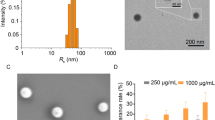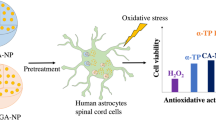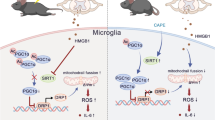Abstract
Oxidative stress and inflammation are central pathophysiological processes in a traumatic spinal cord injury (SCI). Antioxidant therapies that reduce the reactive oxygen and nitrogen species (RONS) overgeneration and inflammation are proved promising for improving the outcomes. However, efficient and long-lasting antioxidant therapy to eliminate multiple RONS with effective neuroprotection remains challenging. Here, a single-atom cobalt nanozyme (Co-SAzyme) with a hollow structure was reported to reduce the RONS and inflammation in the secondary injury of SCI. Among SAzymes featuring different single metal-N sites (e.g., Mn, Fe, Co, Ni, and Cu), this Co-SAzyme showed a versatile property to eliminate hydrogen peroxide (H2O2), superoxide anion (O ·−2 ), hydroxyl radical (·OH), nitric oxide (·NO), and peroxynitrite (ONOO−) that overexpressed in the early stage of SCI. The porous hollow structure also allowed the encapsulation and sustained release of minocycline for neuroprotection in synergy. In vitro results showed that the Co-SAzyme reduced the apoptosis and pro-inflammatory cytokine levels of microglial cells under oxidative stress. In addition, the Co-SAzyme combined with minocycline achieved remarkable improved functional recovery and neural repairs in the SCI-rat model.

Similar content being viewed by others
References
Ahuja, C. S.; Wilson, J. R.; Nori, S.; Kotter, M. R. N.; Druschel, C.; Curt, A.; Fehlings, M. G. Traumatic spinal cord injury. Nat. Rev. Dis. Primers 2017, 3, 17018.
Fischer, I.; Dulin, J. N.; Lane, M. A. Transplanting neural progenitor cells to restore connectivity after spinal cord injury. Nat. Rev. Neurosci. 2020, 21, 366–383.
Jia, Z.; Zhu, H.; Li, J.; Wang, X.; Misra, H.; Li, Y. Oxidative stress in spinal cord injury and antioxidant-based intervention. Spinal Cord 2012, 50, 264–274.
Coyoy-Salgado, A.; Segura-Uribe, J. J.; Guerra-Araiza, C.; Orozco-Suarez, S.; Salgado-Ceballos, H.; Feria-Romero, I. A.; Gallardo, J. M.; Orozco-Barrios, C. E. The importance of natural antioxidants in the treatment of spinal cord injury in animal models: An overview. Oxid. Med. Cell Longev. 2019, 2019, 3642491.
Hall, E. D. Antioxidant therapies for acute spinal cord injury. Neurotherapeutics 2011, 8, 152–167.
Kim, J. W.; Mahapatra, C.; Hong, J. Y.; Kim, M. S.; Leong, K. W.; Kim, H. W.; Hyun, J. K. Functional recovery of contused spinal cord in rat with the injection of optimal-dosed cerium oxide nanoparticles. Adv. Sci. 2017, 4, 1700034.
Hutson, T. H.; Di Giovanni, S. The translational landscape in spinal cord injury: Focus on neuroplasticity and regeneration. Nat. Rev. Neurol. 2019, 15, 732–745.
Andrabi, S. S.; Yang, J.; Gao, Y.; Kuang, Y. Z.; Labhasetwar, V. Nanoparticles with antioxidant enzymes protect injured spinal cord from neuronal cell apoptosis by attenuating mitochondrial dysfunction. J. Control. Release 2020, 317, 300–311.
Liang, M. M.; Yan, X. Y. Nanozymes: From new concepts, mechanisms, and standards to applications. Acc. Chem. Res. 2019, 52, 2190–2200.
Huang, Y. Y.; Ren, J. S.; Qu, X. G. Nanozymes: Classification, catalytic mechanisms, activity regulation, and applications. Chem. Rev. 2019, 119, 4357–4412.
Bains, M.; Hall, E. D. Antioxidant therapies in traumatic brain and spinal cord injury. Biochim. Biophys. Acta (BBA)-Mol. Basis Dis. 2012, 1822, 675–684.
Fan, Y.; Liu, S. G.; Yi, Y.; Rong, H. P.; Zhang, J. T. Catalytic nanomaterials toward atomic levels for biomedical applications: From metal clusters to single-atom catalysts. ACS Nano 2021, 15, 2005–2037.
Xiang, H. J.; Feng, W.; Chen, Y. Single-atom catalysts in catalytic biomedicine. Adv. Mater. 2020, 32, 1905994.
Jiang, B.; Guo, Z. J.; Liang, M. M. Recent progress in single-atom nanozymes research. Nano Res. 2023, 16, 1878–1889.
Pei, J. H.; Zhao, R. L.; Mu, X. Y.; Wang, J. Y.; Liu, C. L.; Zhang, X. D. Single-atom nanozymes for biological applications. Biomater. Sci. 2020, 8, 6428–6441.
Jin, C. Y.; Fan, S. J.; Zhuang, Z. C.; Zhou, Y. S. Single-atom nanozymes: From bench to bedside. Nano Res. 2023, 16, 1992–2002.
Cao, S. J.; Zhao, Z. Y.; Zheng, Y. J.; Wu, Z. H.; Ma, T.; Zhu, B. H.; Yang, C. D.; Xiang, X.; Ma, L.; Han, X. L. et al. A library of ROS-catalytic metalloenzyme mimics with atomic metal centers. Adv. Mater. 2022, 34, 2200255.
Wu, W. W.; Huang, L.; Wang, E. K.; Dong, S. J. Atomic engineering of single-atom nanozymes for enzyme-like catalysis. Chem. Sci. 2020, 11, 9741–9756.
Jiao, L.; Yan, H. Y.; Wu, Y.; Gu, W. L.; Zhu, C. Z.; Du, D.; Lin, Y. H. When nanozymes meet single-atom catalysis. Angew. Chem., Int. Ed. 2020, 59, 2565–2576.
Ji, S. F.; Jiang, B.; Hao, H. G.; Chen, Y. J.; Dong, J. C.; Mao, Y.; Zhang, Z. D.; Gao, R.; Chen, W. X.; Zhang, R. F. et al. Matching the kinetics of natural enzymes with a single-atom iron nanozyme. Nat. Catal. 2021, 4, 407–417.
Jin, X. Y.; Gao, F.; Qin, M. X.; Yu, Y. P.; Zhao, Y.; Shao, T. Y.; Chen, C.; Zhang, W. H.; Xie, B.; Xiong, Y. J. et al. How to make personal protective equipment spontaneously and continuously antimicrobial (incorporating oxidase-like catalysts). ACS Nano 2022, 16, 7755–7771.
Chen, Y. J.; Wang, P. X.; Hao, H. G.; Hong, J. J.; Li, H. J.; Ji, S. F.; Li, A.; Gao, R.; Dong, J. C.; Han, X. D. et al. Thermal atomization of platinum nanoparticles into single atoms: An effective strategy for engineering high-performance nanozymes. J. Am. Chem. Soc. 2021, 143, 18643–18651.
Zhang, S. F.; Li, Y. H.; Sun, S.; Liu, L.; Mu, X. Y.; Liu, S. H.; Jiao, M. L.; Chen, X. Z.; Chen, K.; Ma, H. Z. et al. Single-atom nanozymes catalytically surpassing naturally occurring enzymes as sustained stitching for brain trauma. Nat. Commun. 2022, 13, 4744.
Cai, S. F.; Liu, J. M.; Ding, J. W.; Fu, Z.; Li, H. L.; Xiong, Y. L.; Lian, Z.; Yang, R.; Chen, C. Y. Tumor-microenvironment-responsive cascade reactions by a cobalt-single-atom nanozyme for synergistic nanocatalytic chemotherapy. Angew. Chem., Int. Ed. 2022, 61, e202204502.
Zhang, R. F.; Xue, B.; Tao, Y. H.; Zhao, H. Q.; Zhang, Z. X.; Wang, X. N.; Zhou, X. Y.; Jiang, B.; Yang, Z. L.; Yan, X. Y. et al. Edge-site engineering of defective Fe−N4 nanozymes with boosted catalase-like performance for retinal vasculopathies. Adv. Mater. 2022, 34, 2205324.
Xu, B. L.; Li, S. S.; Zheng, L. R.; Liu, Y. H.; Han, A. L.; Zhang, J.; Huang, Z. J.; Xie, H. J.; Fan, K. L.; Gao, L. Z. et al. A bioinspired five-coordinated single-atom iron nanozyme for tumor catalytic therapy. Adv. Mater. 2022, 34, 2107088.
Zhu, Y.; Wang, W. Y.; Cheng, J. J.; Qu, Y. T.; Dai, Y.; Liu, M. M.; Yu, J. N.; Wang, C. M.; Wang, H. J.; Wang, S. C. et al. Stimuli-responsive manganese single-atom nanozyme for tumor therapy via integrated cascade reactions. Angew. Chem., Int. Ed. 2021, 60, 9480–9488.
Chang, M. Y.; Hou, Z. Y.; Wang, M.; Yang, C. Z.; Wang, R. F.; Li, F.; Liu, D. L.; Peng, T. L.; Li, C. X.; Lin, J. Single-atom Pd nanozyme for ferroptosis-boosted mild-temperature photothermal therapy. Angew. Chem., Int. Ed. 2021, 60, 12971–12979.
Cao, F. F.; Zhang, L.; You, Y. W.; Zheng, L. R.; Ren, J. S.; Qu, X. G. An enzyme-mimicking single-atom catalyst as an efficient multiple reactive oxygen and nitrogen species scavenger for sepsis management. Angew. Chem., Int. Ed. 2020, 59, 5108–5115.
Huang, L.; Chen, J. X.; Gan, L. F.; Wang, J.; Dong, S. J. Single-atom nanozymes. Sci. Adv. 2019, 5, eaav5490.
Zhu, X. Y.; Wu, J. B.; Liu, R. X.; Xiang, H. D.; Zhang, W. Q.; Chang, Q. C.; Wang, S. S.; Jiang, R.; Zhao, F.; Li, Q. Q. et al. Engineering single-atom iron nanozymes with radiation-enhanced self-cascade catalysis and self-supplied H2O2 for radio-enzymatic therapy. ACS Nano 2022, 16, 18849–18862.
Zhao, Y.; Yu, Y. P.; Gao, F.; Wang, Z. Y.; Chen, W. X.; Chen, C.; Yang, J.; Yao, Y. C.; Du, J. Y.; Zhao, C. et al. A highly accessible copper single-atom catalyst for wound antibacterial application. Nano Res. 2021, 14, 4808–4813.
Huo, M. F.; Wang, L. Y.; Wang, Y. W.; Chen, Y.; Shi, J. L. Nanocatalytic tumor therapy by single-atom catalysts. ACS Nano 2019, 13, 2643–2653.
Zhu, D. M.; Chen, H.; Huang, C. Y.; Li, G. X.; Wang, X.; Jiang, W.; Fan, K. L. H2O2 self-producing single-atom nanozyme hydrogels as light-controlled oxidative stress amplifier for enhanced synergistic therapy by transforming “cold” tumors. Adv. Funct. Mater. 2022, 32, 2110268.
Qin, L. M.; Gan, J.; Niu, D. C.; Cao, Y. Q.; Duan, X. Z.; Qin, X.; Zhang, H.; Jiang, Z.; Jiang, Y. J.; Dai, S. et al. Interfacial-confined coordination to single-atom nanotherapeutics. Nat. Commun. 2022, 13, 91.
He, H.; Fei, Z. Y.; Guo, T. L.; Hou, Y.; Li, D.; Wang, K. F.; Ren, F. Z.; Fan, K. L.; Zhou, D. J.; Xie, C. M. et al. Bioadhesive injectable hydrogel with phenolic carbon quantum dot supported Pd single atom nanozymes as a localized immunomodulation niche for cancer catalytic immunotherapy. Biomaterials 2022, 280, 121272.
Du, Z. Z.; Chen, X. J.; Hu, W.; Chuang, C. H.; Xie, S.; Hu, A. J.; Yan, W. S.; Kong, X. H.; Wu, X. J.; Ji, H. X. et al. Cobalt in nitrogen-doped graphene as single-atom catalyst for high-sulfur content lithium-sulfur batteries. J. Am. Chem. Soc. 2019, 141, 3977–3985.
Lazar, P.; Mach, R.; Otyepka, M. Spectroscopic fingerprints of graphitic, pyrrolic, pyridinic, and chemisorbed nitrogen in N-doped graphene. J. Phys. Chem. C 2019, 123, 10695–10702.
Yang, H. B.; Miao, J. W.; Hung, S. F.; Chen, J. Z.; Tao, H. B.; Wang, X. Z.; Zhang, L. P.; Chen, R.; Gao, J. J.; Chen, H. M. et al. Identification of catalytic sites for oxygen reduction and oxygen evolution in N-doped graphene materials: Development of highly efficient metal-free bifunctional electrocatalyst. Sci. Adv. 2016, 2, e1501122.
Yang, J.; Zhang, R. F.; Zhao, H. Q.; Qi, H. F.; Li, J. Y.; Li, J. F.; Zhou, X. Y.; Wang, A. Q.; Fan, K. L.; Yan, X. Y. et al. Bioinspired copper single-atom nanozyme as a superoxide dismutase-like antioxidant for sepsis treatment. Exploration 2022, 2, 20210267.
Wu, J. J. X.; Yu, Y. J.; Cheng, Y.; Cheng, C. Q.; Zhang, Y. H.; Jiang, B.; Zhao, X. Z.; Miao, L. Y.; Wei, H. Ligand-dependent activity engineering of glutathione peroxidase-mimicking MIL-47(V) metal-organic framework nanozyme for therapy. Angew. Chem., Int. Ed. 2021, 60, 1227–1234.
Acknowledgements
This research was financially supported by the National Natural Science Foundation of China (Nos. 22175048, 22005027, and 51890892) and Tianjin Health Commission (No. ZC20175). We thank the assistance from 1W1B beamline at Beijing Synchrotron Radiation Facility in XAFS measurements and Analysis & Testing Center of Beijing Institute of Technology in TEM observations. The animal study protocol was approved by the Institutional Animal Care and Use Committee at the National Center for Nanoscience and Technology (NCNST).
Author information
Authors and Affiliations
Corresponding authors
Electronic Supplementary Material
Rights and permissions
About this article
Cite this article
Jiang, Y., Rong, H., Wang, Y. et al. Single-atom cobalt nanozymes promote spinal cord injury recovery by anti-oxidation and neuroprotection. Nano Res. 16, 9752–9759 (2023). https://doi.org/10.1007/s12274-023-5588-z
Received:
Revised:
Accepted:
Published:
Issue Date:
DOI: https://doi.org/10.1007/s12274-023-5588-z




